
|

|
| Use the text links for more information! |
|
A half hour walk should see you guzzling your first pint in the New
Inn but first theres a bit of walking to be done. Carry on walking up Chudleigh Road.
The large white cottage on the right is Belvoir, a grade 2 listed house thought to have it's origins in the C17th, Belvoir together with 18 pricipal houses and 300 acres in and around Alphington, formed the Alphington Estate owned by the Earls of Devon. Aldens Farm
Aldens Farm is opposite. The Rev Alden was a former rector. At one time there was a tunnel leading from this farm to the church. Aldens Road is also named after the Reverend. Thomas Alden became rector in 1637. He was a scholar of St John's College, Cambridge. He was recommended by Charles I for the next vacant canonry but never obtained that position. He was evicted during the commonwealth and died in 1651. His successor was John Alden who was evicted in 1662 but returned and was rector from 1662 to 1667, doing much work on the restoration of the church. Head on across the two mini-roundabouts and further on up Chudleigh Road, you'll see Shillingford Road on your right. |
| Ministry and Housing
After WW1,
the Ministry of Pensions purchased land around Shillingford Hill (now Road) and
Chudlieigh Road to provide housing for ex-servicemen and their families. Ten semi-detached
houses were built in Shillinford Road in 1921 (occupied in 1922) and each had 2 acres of
land.
The idea was that small holdings could be developed. Pigs and poultrey were also
kept. |
With time the ex-servicemen were unable to work the land or simply passed away. Devon
County Council took over the small holdings and the land at the rear of the properties
reverted to Aldens Farm and later Exeter City Council when the City's boundaries were
extended.
The original houses had sewerage and electricity connected in the 1930's when there was further building on the other side of Shillingford Road. Since then, Willsdown Road (1974), Aldens Grange (1986), Sobeys Farm (1985), Chantry Meadows (early 1990's), the Fairfield Estate (1962), Raglans (1960), Veitch Gardens (early 1990's), Alphin Brook (2002), Alphington Halt (2006) have all been built. Keep walking. |
| Exon View
Eventually you'll see a white gate, this is the entrance to
Silverlands. Keep walking.
The house shown in the second picture is The Gables but
was originally known as Exon Veiw. It was in fact one
of the old Alphington Manor Houses and appears to have excellent views
of Exeter. Twenty two rooms are housed within the 1730 structure
which was later augmented in 1820. The house was at one time used as a prison
for the poor sods waiting to be hanged from an old oak tree at the Four
Cross Way on the Shillingford Road. A tunnel still exists about 25 metres
long from the cellars through which the aforementoined losers were taken.
Their bodies were brought back along Hangman's Lane (now Markhams Lane)
and buried opposite the house on the other side of the road.
Don't try walking along Markhams Lane unless you enjoy playing dodge the doggy do
do. There should be a law against it. I've never seen so many turds in
one place in my life!
The cellar of the house is now sealed.
|
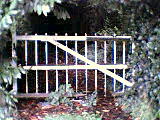
|
| Retrace your steps back towards the church, past Scanes Cottages and turn left up Ide Lane. Parr's Cottages used to occupy the site now filled with Lockfield Court. On the other side of the road is Ventlake, another old Alphington House. |
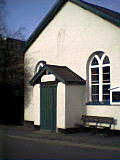
|
Village Hall
Notice the Village Hall on your right, this was the original school, established in 1812
and supported by donation. The 'old school' then became the reading
room and eventually the Church Institute, now the Village Hall. The first headmaster was Thomas
Brewer and the school was a 'National' school. At first the school only taught reading, with writing and arithmetic
being taught later. National schools only had one master, 'monitors', the brightest senior
boys passed on their knowledge to the younger ones. At the time there were also 3 or 4 'dames'
schools locally were attendance was voluntary costing a few pence. Minor clergy also supplemented
their income by teaching the children of the local gentry, their young girls being educated at
home by a governess. Clerical teaching took place in a building near the rectory, the end wall of
which can be seen adjacent to the Lytch Gate entrance to the Churchyard. It is likely that
Charles Babbage attended school here.
This very same building was used during the Crimean War
to spread the news from the battle-front. At the time, papers were scarce and carried a heavy tax.
Strangely I have also heard this building described as an apple loft. There were at one time
large orchards all over the area to the south of Alphin Brook. It obviously had multi-uses. The
pictures show doors at ground level and at loft level to the rear.
|
| Sick Note
Also of note by the Village Hall is Alphington Surgery, built in 1993 to replace the former
surgery in Lovelace Gardens. This building is superb and was designed to be sympathetic to the
residential surroundings and provide a bright welcoming atmosphere inside. A clever use of wood,
tile and glass with an octagonal plan makes it worth getting a doctors note for your running sores,
hangover and syphilis.
The building was designed by an Exeter firm of architects, Nigel Grainge Architects. The only
problem is that it is hidden away from view. My picture does not do it justice.
The Pharmacy was opened in June 2007 with the extension of an existing house. The old pharmacy in Church Road was
located at Tozers Cottage.
Barn Cottage
The yellow cottage over the road was originally Barn Cottage (now Burgoynes) and was built in 1627. It was possibly
built as the barn for Burgoynes, which as you might remember was the original house name of the building that is now
the Admiral Inn.
|
 |
Corner Shop Keep walking along Ide Lane to the corner shop. Myrtle Close was built around 1965 together with the corner shop, the area around here was originally market gardens owned by the Grime's family. Many of the inhabitants of Alphington prior to the second world war were employed in the market garden industry. |
The cottages opposite the shop date from at least as early as 1833. No.29 was owned by a William Holmes in 1833
and prior to that by the Earl Of Devon. These cottages were once known as 1,2, and 3 Myrtle Cottages before being
given Ide Lane numbers. No 29 was known as Myrtle Cottage. They are of both cob and brick.
In 1889 they belonged to John Routley who was a tennant at the recently re-named Admiral Vernon Inn. |
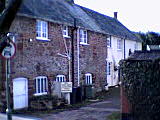 |
Old Mill Keep walking, just past the school on your right is a footpath (Mill Lane), leading to the Old Mill. Nip down here 60 metres, the mill is on your left. This was an old corn mill which stopped milling in the 1930's. It is now a guest house. The water wheel was supplied by a leat which ran off the Alphin Brook about 3/4 of a mile upstream. There is still a small weir on the brook which diverted the water from this point. Click here for more information, map and pictures. This page also shows details of where the leat can still be seen issuing back into the brook and where the water wheel was housed. Retrace your steps and head over Wheatsheaf Way, and up Ide Lane. |
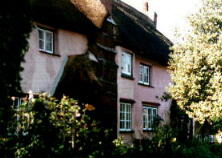 |
Gidleys Gidleys is one of the first cottages you'll come to, this is possibly one of the oldest houses in Alphington, built with cob walls and thatch. Bartholomew Gidley settled in Alphington sometime before 1612, the family name being lost in Alphington after 1695. A farm previously went with the house but became part of Sobeys Farm in the mid 1850's. Sobeys Farm was more recently sold by it's last owner, Percy Dadd for the development of homes, the field on the other side of Wheatsheaf Way was used to build the new Alphington Combined School. There are details of a sale by Husseys in 1962 of farm buildings for sale by tender. Percy Dadd used to supply horses and drive the carriages for visiting judges at Exeter assizes. The farm house stood roughly at the Wheatsheaf Way / Smithfield Road intersection. |
| Midway
The homes built have a postal address of Sobeys Farm, those built
slightly later towards Shillingford Road were in a development known as Aldens Grange,
presumably signifying that the land was also previously owned by Rev. Alden.
A little further down Ide Lane on the left
are the cottages of Midway Terrace. These cottages were constructed to house the workmen
cutting the Exeter to Newton Abbot branch of the Teign Valley Railway, engineered by
Brunel.
The railway opened in 1882, and was later amalgamated into the Great Western Railway in 1923.
|
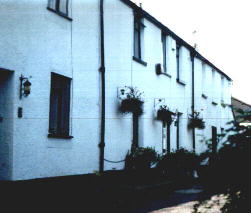 |
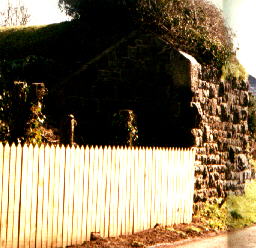 |
Teign Valley Railway At the bottom of this lane, about 150 metres you'll find the remains of an old railway bridge. This bridge once took the Exeter-Newton Abbot branch line which closed on 9th June 1958 after the British Railways Modernisation Plan of 1955. It used to stay on the trajectory you'll see until beyond the A30 link roundabout after which it swung sharply to the right towards Ide and eventually to Newton Abbot. Chips Barber's, The Teign Valley Of Yesteryear carries several pictures of this railway. See Obelisk Publications available through the Acknowledgements page. |
| Keep going, go through the access path in the fence and turn right back towards Alphington and Exeter. Just before you reach the right turn back into Alphington along Church Road, take a look at the thirteenth century cross over the road, the cross has been re-located several times in order to allow revised traffic flow schemes and dates from the C13th. Traditionally it marked the boundary between the parishes Alphington and St Thomas'. The bible states that monuments marking city boundaries must never be moved or God would strike dead the person who moved them! |
It was last relocated in 1998 from its old site which is now the entrance
to Sainsbury's. Unfortunately the cross was broken during this last move
and the cross is now held together by cement.
I hate to think what God has done to the dummy who broke it. The site it now occupies is very close to the original position just under the old railway bridge (now removed) by the line of white cottages before the main road to Exeter. You'll need a picture. |
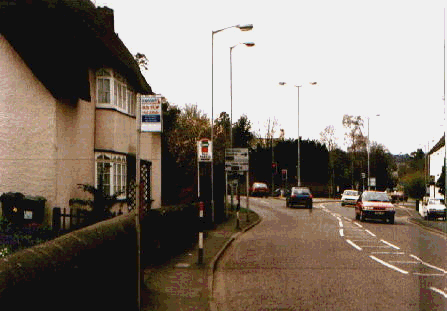 |
| Alphington Halt
Alphington Halt railway station is now occupied by Alphington Halt housing development which was coompleted in 2006. The
station was located on an emankment and was a 100ft long wooden platform with a flat roofed corrugated shelter located
on the eastern side of the track, reached by a footpath. The station opened on 2nd April 1928.
On some summer Saturdays in the 1950's one train from Newton Abbott terminated at Alphington Halt and passengers
continued to Exeter by bus because St. David's Station was very busy with holiday trains in the middle of the day.
|
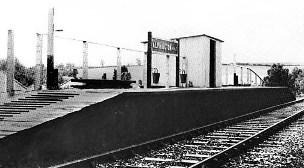 Alphington Halt closed 9th June 1958 |
| Government Buildings
This railway line used to cut across
what is now Marsh Barton Industrial Estate and link up with the railway
bridge close to Wickes superstore. The embankment can still be seen behind
Sainsbury's.
Before Sainsburys opened in 1998, the site was occupied by the General
Post Office (GPO), and British Telecom who were once part of the GPO. This was
in Pre Margaret Thatcher days.
The company's tenure went back as far as 1953.
|
The Ministry of Agriculture also had offices here when the buildings first opened.
They were built after World War 2 and were designed in an 'American Hospital' style with long wings which were to be used as wards in the event of war. Fortunately they never were used for this purpose. |